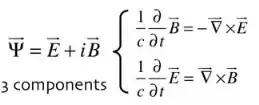Contrary to a comment, there does exist a wave function for the photon because the quantized Maxell's equation, where the derivatives are interpreted as operators acting on the wave function represents the photon quantum mechanically.
In this link one can see the analogue between electron and photon wave equations;
In modern terms, a photon is an elementary excitation of the quantized electromagnetic field. If it is known a priori that only one such excitation exists, it can be treated as a (quasi) particle, roughly analogous to an electron.
These are in E and B classical fields, but these are connected with the four vector potential, as discussed here.
It should be clear that an individual photon does not have an electric or magnetic field when measured. These reside in the complex valued wave function :

Note that it is a vector, because of the spin 1 as explained in the link.
It is the superposition of innumerable complex photon wave functions that build up real valued E and B fields of classical electromagnetism. Remember that to get a measurable observable one has to square this superposed huge wave function, so it is not a one to one correspondence from quantum to classical.
How the classical electromagnetic field emerges from a confluence of photons, is shown, using the Quantum Filed Theory formalism in this blog by Motl.
The bottom line is that classical electromagnetism solutions work very well and in courses no emphasis is given to the underlying quantum mechanical wave function. of the photons.
